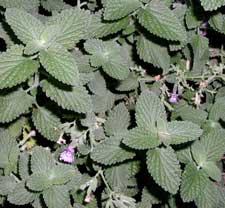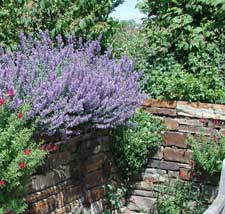Resource Library
Plant of the Week: Walker's Low Catmint
The University of Arkansas System Division of Agriculture does not promote, support or recommend plants featured in "Plant of the Week." Please consult your local Extension office for plants suitable for your region.
Plant of the Week
Walker’s Low Catmint
Latin: Nepeta x faassenii

Plant people are fond of creating “best” lists of plants in an attempt to simplify the choices for gardeners looking for clarity in the oftentimes confusing plant world. That there is little agreement on what the best plants are is beside the point. At least we try. Today let’s consider the best – like I mean really the very best – perennial, Walker’s Low Catmint (Nepeta x fassenii ‘Walker’s Low’).
When in flower, this member of the mint family reaches about 18 inches tall with a spread to 2 feet across. Out of flower the foliage forms, a compact mound about 8 inches tall. Being a mint, the leaves are evergreen to about 15 degrees, opposite, about 2 inches long, gray-green and fragrant when crushed. It doesn’t produce pesky underground rhizomes like some mints but grows from a slowly expanding central crown.
Though called catmint, cats aren’t attracted to this plant like the true catnip, N. cataria. Deer and rabbits don’t care much for it either.
The flowers are what make catmint a real standout. They appear in midspring and continue to be produced through most of the growing season, although late spring and early summer is their showiest time. The lavender-blue flowers are produced on upright spikes held above the foliage that reach about 8 inches long. Individual flowers are small but produced in large numbers up the spike. Because the plant is a sterile hybrid and doesn’t set seed, it just keeps blooming in a vain attempt to procreate.

This plant is apparently an accidental hybrid between N. racemosa and N. nepetella that occurred in the lower part of Mrs. Walker’s garden in Ireland. Mrs. Patricia Taylor spotted its potential and took cuttings in the 1970’s. Four Seasons Nursery in Norwich, England, finally introduced it to the trade in 1988. The first hybrids of these two species were made by Dutch nurseryman J. H. Faassen in the 1930s, so the hybrid genus is named in his honor.
Walker’s Low, named for the garden - not the plant size, is a favorite amongst garden designers because its long bloom period makes it the ideal filler plant in the mixed perennial border. Plants tucked here and there in the front of the border provide unity to the design and lots of color over much of the growing season. It’s also ideal for edging walkways or use as a groundcover. It also can be used in containers, even containers that remain outside over winter.
And it’s tough – really tough. The Perennial Plant Association agrees about its toughness and wide adaptation so the association selected it as the 2007 perennial of the year. It’s adapted from zones 4 through 7.
Catmint should be grown in sunny, well-drained sites in a good garden soil. Wet wintertime conditions could finish it off. It grows in the shade but expect few flowers. Once established, it has great drought tolerance. It responds well to fertilization and will remain in bloom longer with good fertility levels. Cutting off the spent bloom spikes keeps the plants tidy and may help spur more flowers.
This plant has no serious pests, but after four or five years in one site it tends to look a bit shopworn. Dig and divide the plant in early spring and incorporate compost into the soil if plants are to go back in the same area. Propagation is by division or cuttings.
By: Gerald Klingaman, retired
Extension Horticulturist - Ornamentals
Extension News - July 27, 2007
The University of Arkansas System Division of Agriculture does not maintain lists of retail outlets where these plants can be purchased. Please check your local nursery or other retail outlets to ask about the availability of these plants for your growing area.